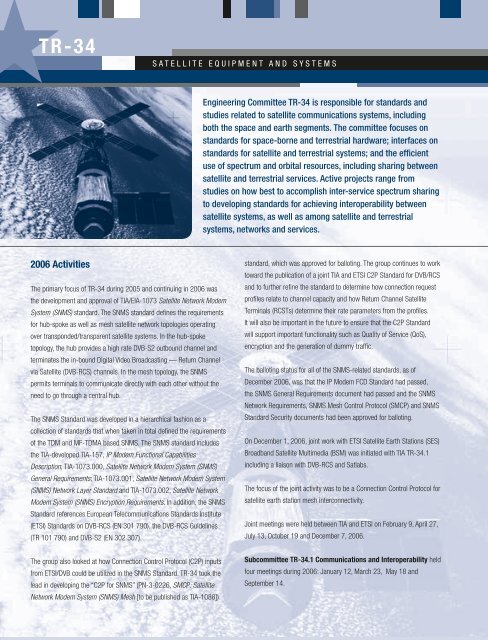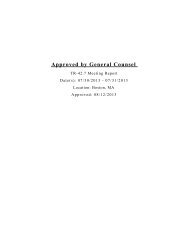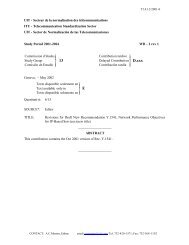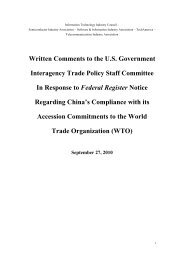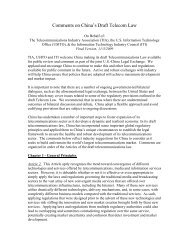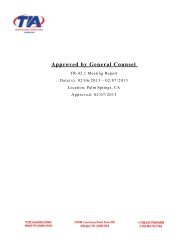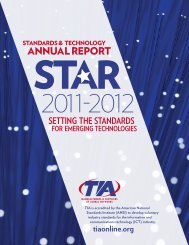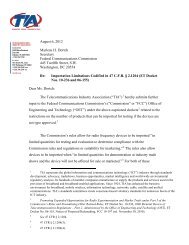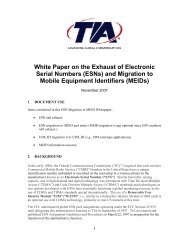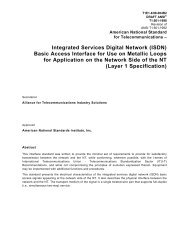TIA:STAR - Telecommunications Industry Association
TIA:STAR - Telecommunications Industry Association
TIA:STAR - Telecommunications Industry Association
Create successful ePaper yourself
Turn your PDF publications into a flip-book with our unique Google optimized e-Paper software.
TR-34<br />
SATELLITE EQUIPMENT AND SYSTEMS<br />
Engineering Committee TR-34 is responsible for standards and<br />
studies related to satellite communications systems, including<br />
both the space and earth segments. The committee focuses on<br />
standards for space-borne and terrestrial hardware; interfaces on<br />
standards for satellite and terrestrial systems; and the efficient<br />
use of spectrum and orbital resources, including sharing between<br />
satellite and terrestrial services. Active projects range from<br />
studies on how best to accomplish inter-service spectrum sharing<br />
to developing standards for achieving interoperability between<br />
satellite systems, as well as among satellite and terrestrial<br />
systems, networks and services.<br />
2006 Activities<br />
The primary focus of TR-34 during 2005 and continuing in 2006 was<br />
the development and approval of <strong>TIA</strong>/EIA-1073 Satellite Network Modem<br />
System (SNMS) standard. The SNMS standard defi nes the requirements<br />
for hub-spoke as well as mesh satellite network topologies operating<br />
over transponded/transparent satellite systems. In the hub-spoke<br />
topology, the hub provides a high rate DVB-S2 outbound channel and<br />
terminates the in-bound Digital Video Broadcasting — Return Channel<br />
via Satellite (DVB-RCS) channels. In the mesh topology, the SNMS<br />
permits terminals to communicate directly with each other without the<br />
need to go through a central hub.<br />
The SNMS Standard was developed in a hierarchical fashion as a<br />
collection of standards that when taken in total defi ned the requirements<br />
of the TDM and MF-TDMA based SNMS. The SNMS standard includes<br />
the <strong>TIA</strong>-developed <strong>TIA</strong>-157, IP Modem Functional Capabilities<br />
Description; <strong>TIA</strong>-1073.000, Satellite Network Modem System (SNMS)<br />
General Requirements; <strong>TIA</strong>-1073.001, Satellite Network Modem System<br />
(SNMS) Network Layer Standard and <strong>TIA</strong>-1073.002, Satellite Network<br />
Modem System (SNMS) Encryption Requirements. In addition, the SNMS<br />
Standard references European <strong>Telecommunications</strong> Standards Institute<br />
(ETSI) Standards on DVB-RCS (EN 301 790), the DVB-RCS Guidelines<br />
(TR 101 790) and DVB-S2 (EN 302 307).<br />
The group also looked at how Connection Control Protocol (C2P) inputs<br />
from ETSI/DVB could be utilized in the SNMS Standard. TR-34 took the<br />
lead in developing the “C2P for SNMS” (PN-3-0226, SMCP: Satellite<br />
Network Modem System (SNMS) Mesh [to be published as <strong>TIA</strong>-1088])<br />
standard, which was approved for balloting. The group continues to work<br />
toward the publication of a joint <strong>TIA</strong> and ETSI C2P Standard for DVB/RCS<br />
and to further refi ne the standard to determine how connection request<br />
profi les relate to channel capacity and how Return Channel Satellite<br />
Terminals (RCSTs) determine their rate parameters from the profi les.<br />
It will also be important in the future to ensure that the C2P Standard<br />
will support important functionality such as Quality of Service (QoS),<br />
encryption and the generation of dummy traffi c.<br />
The balloting status for all of the SNMS-related standards, as of<br />
December 2006, was that the IP Modem FCD Standard had passed,<br />
the SNMS General Requirements document had passed and the SNMS<br />
Network Requirements, SNMS Mesh Control Protocol (SMCP) and SNMS<br />
Standard Security documents had been approved for balloting.<br />
On December 1, 2006, joint work with ETSI Satellite Earth Stations (SES)<br />
Broadband Satellite Multimedia (BSM) was initiated with <strong>TIA</strong> TR-34.1<br />
including a liaison with DVB-RCS and Satlabs.<br />
The focus of the joint activity was to be a Connection Control Protocol for<br />
satellite earth station mesh interconnectivity.<br />
Joint meetings were held between <strong>TIA</strong> and ETSI on February 9, April 27,<br />
July 13, October 19 and December 7, 2006.<br />
Subcommittee TR-34.1 Communications and Interoperability held<br />
four meetings during 2006: January 12, March 23, May 18 and<br />
September 14.<br />
12<br />
2006 STANDARDS AND TECHNOLOGY ANNUAL REPORT


